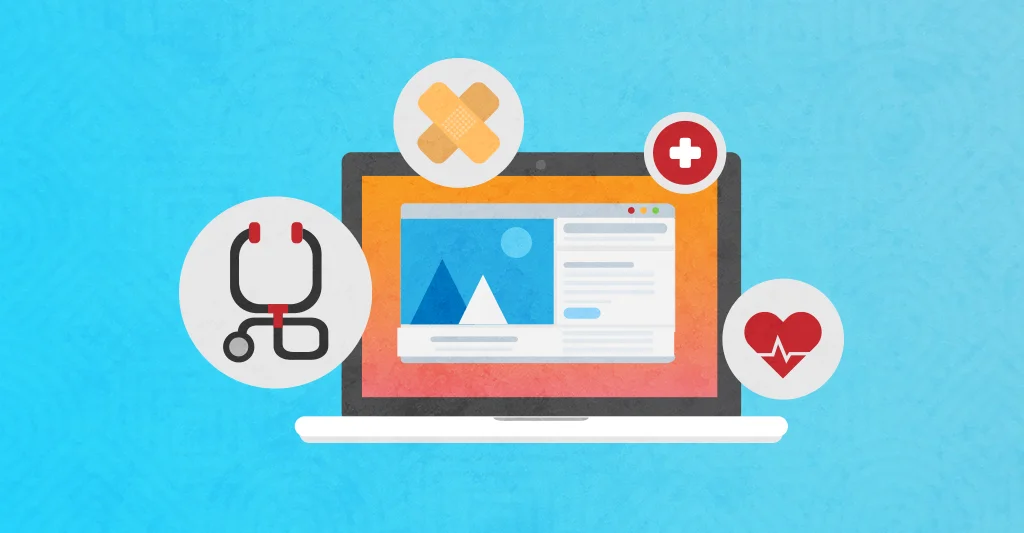Just like a human body, a website is an ever-changing entity that must be properly maintained to ensure its proper functioning
over time. In this article we will see some tips to help you verify that your website always stays healthy!
Introduction
A website is not a static product, but rather an ever-changing element. These changes can come from different sources:
evolving the business, improving web technologies, malicious attacks, etc.
It is therefore extremely important to adapt as best and as quickly as possible in order to ensure a healthy website.
1. Perform system updates
Most modern websites are developed using what is called a content management system (CMS).
These systems allow web developers to create a website with advanced functionality more quickly.
Some of the most popular CMS are Wordpress, Joomla or Drupal.
They also allow users with little technical knowledge to modify the content of website pages without knowing how to program.
Like any computer system, a CMS needs to be updated from time to time.
These updates often aim to:
- Fix bugs
- Offer new features
- Improve website security
Indeed, a system that is not up to date is prey to attacks by hackers who seek to take control of the targeted sites.
In short, update your content management system to protect yourself from hackers, but also to avoid being stuck with bugs or instabilities in your website.
2. Keep your content fresh
When surfing the web, it is common to come across websites with outdated information. However, this can be a great cause of frustration for visitors of a website, even causing losses in terms of customers. It is therefore imperative for any website owner to regularly check whether the content, in terms of texts and images, is still relevant.
Here are some areas where you could improve the content of your site:
- Blog: Was your website's last blog post several months ago?
It might be a good time to give some news to your customers!
- News: If the latest news dates back to your holiday sale from 4 years ago, a refresh is in order!
- Copyright: A quick way to see a company's interest in its website is by the year of the site's copyright notice. Make sure it matches the current year!
- Price list: Visitors like to see accurate prices, can you say that about yours on your website?
- List of services: Check that the list of services your company offers on your website aligns with your current offering.
- Images: Check that all images on your website display correctly.
- Broken links: Make sure all the links on your pages are working properly.
Do you remember the last time you updated your website content?
If you want content that is always fresh and current, follow this advice:
check the elements in the list above once a month and apply fixes if necessary.
3. Make backups
We've talked about your site's vulnerability to hacker attacks, but are you protected in the event of a successful attack by one?
If a hacker manages to gain access to your site, you could lose it completely. In order to avoid this problem, it is possible to make backup copies regularly. This is so as not to be caught off guard if an unfortunate situation were to arise.
Make backup copies of your site regularly (monthly for example) to avoid losing your website in case of problems.
4. Improve page speed performance
Nobody likes a slow website. The loading speed of a website is one of the most important aspects, since it is the most determining element between a visit or an abandonment of your website.
Do you know if your website is fast?
To find out, it is possible to use a specialized tool such as the free performance analysis tool from Morébec
Once the performance of your website has been determined, all you have to do is contact a web performance optimization expert, so that they can help you improve the loading speed of your site using a solid plan of action.
5. Monitoring
Once your website's performance has improved, it's important to reassess it frequently so that you can act quickly if performance drops.
Some performance drops may be caused by:
- An obsolete system (Updates, to do)
- Bugs in the content management system
- A misconfigured web server,
- Accumulation of old stale data on your web server
- A content update that is not properly optimized.
- etc.
Because of the sheer number of reasons, it is imperative to carry out constant monitoring.
One of the best ways to perform this verification would be to use a monitoring service such as
the one we offer.
Conclusion
In conclusion, there are several things website owners need to pay close attention to to ensure their site stays healthy:
- Performing system updates
- Content updates
- Backing up website data
- Page Speed Optimization
- Monitoring
Follow these steps regularly and you should have a healthy website!








